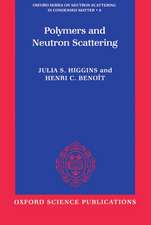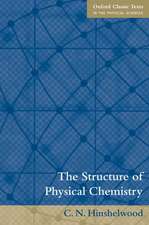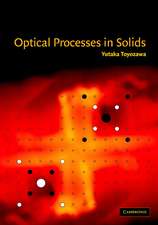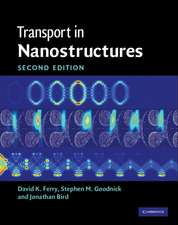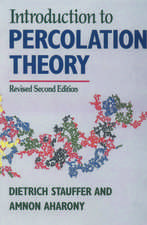X-Ray Diffraction by Disordered Lamellar Structures: Theory and Applications to Microdivided Silicates and Carbons
Gerard Besson Autor Victor A. Drits Cuvânt înainte de Andre Guinier Traducere de R. Setton Alexander S. Bookin Autor Cyril Tchoubar Francoise Rousseaux, Boris A. Sakharov, Denise Tchoubaren Limba Engleză Paperback – 13 dec 2011
Preț: 645.14 lei
Preț vechi: 758.99 lei
-15% Nou
Puncte Express: 968
Preț estimativ în valută:
123.46€ • 127.54$ • 102.75£
123.46€ • 127.54$ • 102.75£
Carte tipărită la comandă
Livrare economică 26 martie-09 aprilie
Preluare comenzi: 021 569.72.76
Specificații
ISBN-13: 9783642748042
ISBN-10: 364274804X
Pagini: 392
Ilustrații: XVII, 371 p.
Dimensiuni: 155 x 235 x 21 mm
Greutate: 0.55 kg
Ediția:Softcover reprint of the original 1st ed. 1990
Editura: Springer Berlin, Heidelberg
Colecția Springer
Locul publicării:Berlin, Heidelberg, Germany
ISBN-10: 364274804X
Pagini: 392
Ilustrații: XVII, 371 p.
Dimensiuni: 155 x 235 x 21 mm
Greutate: 0.55 kg
Ediția:Softcover reprint of the original 1st ed. 1990
Editura: Springer Berlin, Heidelberg
Colecția Springer
Locul publicării:Berlin, Heidelberg, Germany
Public țintă
ResearchCuprins
1 Overall Description of Imperfect Lamellar Crystals.- 1.1 Some Reminders on the Specific Characteristics of Crystals with a Triperiodic Structure.- 1.2 Range of Validity of the Direct Methods of Structural Analysis.- 1.3 Indirect Structural Analysis of Partially Disordered Lamellar Systems. Principles of Their Modelization.- 1.4 Determination of the Structural Characteristics of the Layers.- 1.5 General Characteristics of Triperiodic Layer Stackings.- 1.6 Principal Characteristics of Lamellar Structures with Stacking Faults.- 1.7 Principal Characteristics of Interstratified Minerals.- 1.8 Commensurate and Incommensurate Structures in Interstratified Systems.- References.- 2 Theory of the Diffraction Phenomenon Produced by Powders of Microcrystals with a Lamellar Structure.- 2.1 Diffraction from an Isolated Layer of Finite Extent.- 2.2 Diffraction from a Defect-Free Stack of Identical Layers.- 2.3 Diffraction by a Powder of Particles with Totally Random Orientation.- 2.4 Diffraction from a Powder of Partially Oriented Particles.- References.- 3 Diffraction from Lamellar Crystals with Stacking Faults.- 3.1 General Expression for the Diffraction Produced by Stacks of Layers with Position Defects.- 3.2 Diffraction Produced by Stacks Containing Rotation or Translation Faults Without Mutual Interaction.- 3.3 Diffraction Produced by Stacks with Defects Due to Fluctuations in the Positions of the Layers.- References.- 4 Statistical Models and Parameters Used to Describe Interstratified Lamellar Systems.- 4.1 General Parameters Characterizing the Stacking of Different Layers in Interstratified Structures.- 4.2 Interstratified Structures with S = 0.- 4.3 Interstratified Structures with S = 1.- 4.4 Interstratified Structures with S = 2.- 4.5 Interstratified Structures with S = 3.- 4.6 Degree of Homogeneity for Powders of Thin Particles with Markovian Interstratification (Quasi-Homogeneous System).- 4.7 Parameters for the Characterization of Homogeneous Interstratified Systems.- 4.7.1 Homogeneous Two-Component (A and B) Systems with S = 0.- 4.7.2 Homogeneous Two-Component Systems with S ? 0 and Restrictive Conditions for the Sequence of Layers.- References.- 5 Diffraction Methods Adapted to the Structural Analysis of Interstratified Systems.- 5.1 Direct Methods of Structural Analysis.- 5.2 Indirect Methods of Structural Analysis Based on the Computation of the Intensities of Basal Reflections.- 5.3 Diffraction by Systems with g Types of Layers, with a Specific Translation r Between the Adjacent i-Type and j-Type Layers, for any Given Value of S.- 5.4 Intensity of the Wave Diffracted by Systems with g Types of Layers, for any Value of S and R.- 5.5 General Remarks.- References.- 6 Experimental Techniques Adapted to the Study of Microdivided Lamellar Systems.- 6.1 Survey of the Techniques Most Frequently Used in Powder Diffractometry.- 6.2 Adaptation of Transmission Techniques to the Study of Microdivided Lamellar Systems.- 6.3 Perturbing Factors which can be Minimized.- 6.4 Principal Corrections on the Diffraction Patterns.- 6.5 Perturbing Factors Introduced in the Computation of the Theoretical Diffractograms.- 6.6 Determination of the Absolute Intensity Scale.- References.- 7 Structural Characteristics of Carbons.- 7.1 General Characteristics of Carbon Materials.- 7.2 Structural Characteristics of the Graphitization Process.- 7.3 Organization of the Stacks.- References.- 8 The Modelization Method in the Determination of the Structural Characteristics of Some Layer Silicates: Internal Structure of the Layers, Nature and Distribution of theStacking Faults.- 8.1 Structural Defects in Kaolinite.- 8.2 Distribution of the Cations in the cis and trans Octahedral Sites of Dioctahedral Smectites.- 8.3 Determination of the Distribution of Cations and Water Molecules in the Interlamellar Spaces of Dioctahedral Smectites.- 8.4 Structural Defects in Glauconites.- References.- 9 Determination of the Structural Characteristics of Mixed-Layer Minerals.- 9.1 The Method of D’yakonov.- 9.2 General Guidelines for the Use of Modelization of X-Ray Diffractograms in the Study of Mixed-Layer Minerals.- 9.3 Calculation of the Reference X-Ray Diffractogram for Quasi-Homogeneous Interstratified Minerals.- 9.4 Parameters Other than W and S which Influence the Profile of the Calculated X-Ray Diagrams of Two-Component Interstratified Systems.- 9.5 Quantitative Determination of the Structural Characteristics of Interstratified Dioctahedral Mica-Smectite Minerals.- 9.6 Semi-Quantitative Determinations of the Structural Characteristics of Interstratified Minerals.- References.- Author Index.

